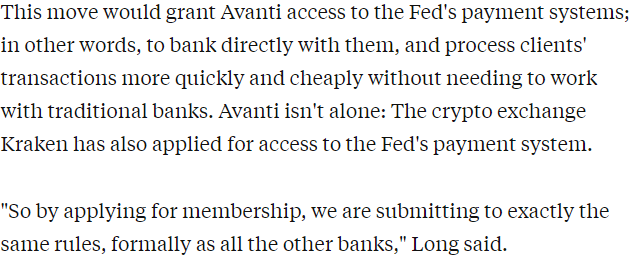
1/ JUST PUBLISHED article abt #stablecoin interoperability in @CentralBanking_ (yep...!)--another collaboration w/ Dr.Manmohan Singh of @IMFNews + my 1st w/ Dr Charles Kahn of Univ of IL. 🚨VERY IMPORTANT NEW POINT included🔥 (behind a firewall but 🧵👇).
centralbanking.com/fintech/789225…
centralbanking.com/fintech/789225…
2/ Best historical analogy for #stablecoins isn't wildcat banking--it's check clearing. Private pre-Fed check clearing networks are analogous to different private stablecoin networks today. What made checks interoperable?
💡2 things: common standard+Fed guarantee of pymt at par
💡2 things: common standard+Fed guarantee of pymt at par
3/ We argue #stablecoin issuers should gain access to Fed payment systems so they can back stablecoins w/ central bank reserves (ie, guarantee of pymt at par to members of Fed's network), but ALSO that the choice of tech should be agnostic. (The mkt has already voted on this.)
4 We acknowledge that non-bank #stablecoin issuers would need to be licensed as banks (not just banks, but full-fledged depository institutions, which are subject to MUCH higher standards than just any bank --to protect against a default by a member depository on the Fed itself).
5/ I'd add the only type of bank available now to #crypto cos that fits this is #Wyoming's #SPDI (special-purpose depository institution) charter. Indeed, SPDI charter was designed to open door to Fed pymt systems for #crypto-native companies. It's not open yet, but stay tuned.
6/ "Allowing stablecoins from banks&non-banks chartered as banks to interoperate–not just by enabling both access central bank pymt systems, but also by enabling use of PUBLIC OPEN-SOURCE TECH PROTOCOLS that already interoperate–will make a diff in pymts/settlements landscape."💪
7/ Yep, above quote appears in a centralbanking.com article, written by 2 respected mainstream economists & me.💪🎉
Many in #crypto ask why I spend so much time w/ mainstream instead of just going around it, as many in our industry do. Answer: US dollar connectivity matters
Many in #crypto ask why I spend so much time w/ mainstream instead of just going around it, as many in our industry do. Answer: US dollar connectivity matters
8/ To repeat, #crypto industry faces a single point of failure risk: US$ banking (only ~$80bn of USD deposit capacity supports industry w/ $2.6trn in asset value when expressed in USD). That bottleneck is an issue on which I've personally been working since 2017, in various ways.
9/ It's a VERY complicated issue, partly related to mkt structure. You all know how critical I can be of mainstream #tradfi mkt structure & some of you have been surprised at how critical I've been about how mkt structure in #crypto has evolved too. It's all consistent tho.
10/ Just remember--my passion is FAIR & STABLE financial mkts. THAT's what I'm working on. Lots more work to do, but my collaborations like this one are very much a part of pushing the proverbial ball forward toward that goal. Enjoy!
• • •
Missing some Tweet in this thread? You can try to
force a refresh






